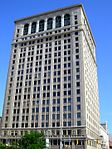Krenzler Field
1985 establishments in OhioAir-supported structuresCleveland City StarsCleveland SCCleveland State Vikings ... and 7 more
College lacrosse venues in the United StatesCollege soccer venues in the United StatesNational Premier Soccer League stadiumsOhio sports venue stubsSoccer venues in OhioSports venues completed in 1985Sports venues in Cleveland

Krenzler Field is a soccer stadium in Cleveland, Ohio on the campus of Cleveland State University (CSU). It serves as the home field to the CSU men's and women's varsity soccer teams, the CSU varsity men's lacrosse team, and formerly the Cleveland City Stars of the USL First Division. Krenzler Field became the home of Cleveland's Minor League Soccer team AFC Cleveland of the National Premier Soccer League in 2013. It is named in honor of Judge Alvin Krenzler.The 1,680-seat stadium was built in 1985 and has received many upgrades since, including the addition of an air supported dome in winter months to provide an indoor practice facility. The field surface is FieldTurf.
Excerpt from the Wikipedia article Krenzler Field (License: CC BY-SA 3.0, Authors, Images).Krenzler Field
Euclid Avenue, Cleveland
Geographical coordinates (GPS) Address Website Nearby Places Show on map
Geographical coordinates (GPS)
| Latitude | Longitude |
|---|---|
| N 41.504166666667 ° | E -81.678611111111 ° |
Address
Cleveland State University
Euclid Avenue 2121
44115 Cleveland
Ohio, United States
Open on Google Maps







